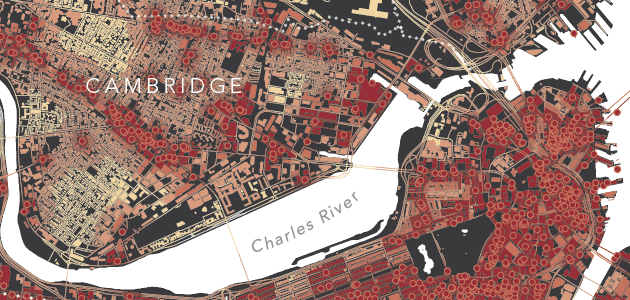People sometimes ask me if cartography is dead. Students wonder if they should pick something else to stake a career in. Professionals wonder if their business will dry up soon. No one really knows what’s coming, or if “cartographer” is soon to be listed alongside “cooper” and “cartwright” in the tally of occupations of yesteryear. In a field disrupted by massive technological changes, uneasiness about the future is commonplace. Twenty years ago a map was a piece of paper, now it’s a bunch of pixels on your smartphone. Graphic artists have given way to software engineers. No one quite knows what they’re doing anymore, or if they have the right skill set to cope with the next big development. Or if it will even be economically feasible for human labor to be much involved in mapmaking at all. Cartography is not dead, but its survival requires thoughtful redefinition. Right now, many of us are not quite sure what cartography involves anymore, and plenty of people who are being paid to make maps aren’t sure if they should call themselves cartographers. There’s a lack of direction, I think, and we’re wondering what will happen to our field next. But rather than waiting for the future to happen to us, I believe cartographers need to clearly assert their role in that future. Instead of being defined by outside forces, we need to tell people that “this is what cartographers do, and here is the valuable part we can play in the new order.” To my mind, the role we articulate must focus on aesthetics and design. Cartography has long had a very technical component to it. Data management, projections, analysis, printing techniques, etc. These remain elements of the job, but their role has decreased as our tools have improved and become more automated. Web cartography has opened a new set of technical challenges, but even then, it takes much less programming knowhow to put together an online map than it did just a couple of years ago. The entry barrier will continue to rapidly decrease. As we go forward, more and more of the technical work will be taken away from us, done by automated algorithms that relieve us of the burdens of data processing, mathematics, and programming. That part of the job is not coming back. What’s left, then, is to focus on the visualization side of things. This is where there is no present substitute for the human brain, nor is there likely to be for a while. A skilled designer knows how to skillfully tell a spatial story, and how a typeface or a color choice affect a reader’s perceptions and moods. Increased automation and improved tools do not lessen the need for creativity and vision. Instead, they free us to spend more time focusing in these things, which no machine can do. This is the value we bring to the process. These skills will endure even as the methods of mapmaking continue to change. 
Not technicians, but storytellers.
This is a tough challenge. There are thousands of cartographers, vs. billions of non-cartographers. Based on sheer numbers, the general populace has most of the power in defining us, and it’s hard to push back. The best thing we can do, though, is to continue to produce better and better maps. The more people see maps as attractive objects with thoughtful, high-quality construction, the more they will think about those things when I tell them I’m a cartographer. What hurts the field is when we see hastily-made, poorly conceived, unattractive, default-heavy maps. The kind made mostly by someone throwing everything together without a lot of thought, letting their tools do the thinking for them. If someone thinks of those when I tell them my profession, then they might quite rightly ask me, “why isn’t a computer doing your job?” The survival of our field depends on us continually demonstrating that we can do things that computers cannot. We must show that we care how the map looks. 
Only our ideas and our abilities as storytellers remain valuable.
Even with these efforts, I expect that cartography as a discipline will shrink. Most people simply don’t need their maps made with a lot of creativity and beauty. They come to us only for our technical skills, and once those are irrelevant, they won’t be coming back. Custom maps of the future will become more and more like the handmade pottery you see at an art fair: more expensive and higher quality, but also in competition with mass-produced, cheap automated stuff that’s good enough for most purposes. All of this is highly speculative, and I could easily be persuaded that I’m wrong. But right now, that’s about the size of my thoughts. We’ll see what happens in the next decade or two. Daniel Huffman is a freelance cartographer, intermittent lecturer, and implacable map critic. He’s also the co-editor of an anthology of world-class cartography, the Atlas of Design. If you follow him on Twitter, you could potentially hear about what he had for dinner.







